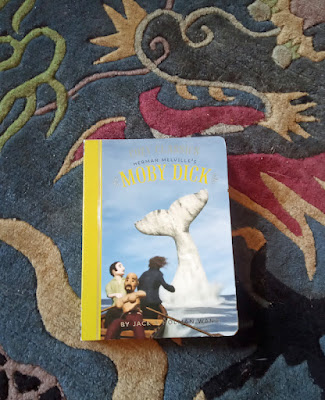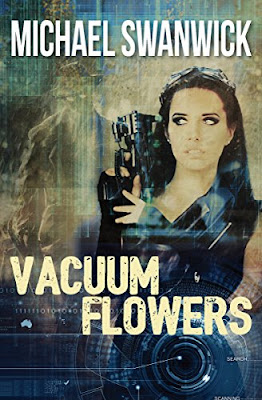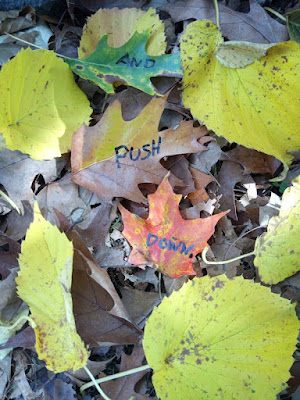.
This seems to be a season for me to post flash fiction! I'm almost at a loss as to how to explain how this story came about. It involved Eileen Gunn, of course. Anything involving Eileen and fiction leaves me feeling addle-brained and confused.
So anyway. Over on Facebook, I somehow got involved in a conversation with the esteemed Ms. Gunn, and it somehow ended in a fiction duel. She was to write a short-short beginning with slapstick and ending with tragedy and I was to write one beginning in tragedy and ending in slapstick. In one day.
Simple, yes? Only Eileen somehow got the assignment turned around and wrote a story beginning darkly and ending in slapstick. So, after posting the first story, which began dark and ended light, I posted a second, which began light and ended dark. All in the prescribed day.
Oh, and for some reason the phrase "Gnomes begone!" was supposed to appear in each story. I can't explain this. Just thinking about it leaves me feeling addle-brained and confused.
The only problem was that Eileen wrote a good story and I wrote two terrible ones. So I picked the one with the opposite overall shape of hers and rewrote it. The first version, I regret to say, involved a lot of goose droppings. Those were the first thing to go away. Also, as long as I was revising the story, I figured I might as well create a history for the fantasy world it occurred within. So I did.
And now I have a story that starts out light and silly and ends up dark and despairing. I cannot explain why it was thought this would be a good idea. Just trying to do so makes me feel confused and... and the other thing.
Anyway, here it is, the distinguished thing:
The Sorcerer’s Daughter
by
Michael Swanwick
Why was her life such a mess? Why did her spells always go wrong? Tisane’s father said she was as naturally powerful as anyone he had ever known—more so even than her late mother, who had been the wonder of the world—but impulsive. “You will be allowed to spell-cast without adult supervision when you’ve mastered calculus and not a minute before.” But she had barely begun learning algebra and already she was fourteen. At this rate, she’d be an old hag before she got to do anything neat.
Thinking dark thoughts, Tisane lugged a bucket of milk fresh-squeezed from their milch cow toward the cheese cave her father had excavated with one magisterial wave of his hand.
Harrawnk! Startled by who knew what, one of the geese hysterically half-flew half-ran past Tisane and into the barn, whose door she had accidentally left open. With a sigh, she put down the bucket and went after the silly thing.
Inside, the goose had somehow flapped and struggled its way up onto a high shelf, far beyond Tisane’s reach. In its panic, it had gotten lodged among the assortment of ancient machines from the Age of Science, which her father always meant to get around to examining someday. Honking bitterly, it endlessly bemoaned its plight.
Well, Tisane thought. Here was a good opportunity to try out her theory that magic was chiefly a matter of confidence. Her father was taking his mid-afternoon nap and wouldn’t enjoy being awakened for so small a matter. So she’d save him the inconvenience. Cocking her wrists and wriggling her fingers witchily, she shouted, “Down from the shelf, you goose!”
Poof! Small, soft feathers exploded into the air. (Tisane inhaled one and almost choked before she managed to cough it free.) Out from the center of that white cloud flew the bedraggled-looking goose. Riding atop it, thin legs closed about its neck was a laughing, red-capped elf.
“Fool!” the elf gloated. “I am your doom! I will unstitch your sacks of flour and topple your buckets of milk!” He flew the goose straight at Tisane. If she hadn’t ducked, it would have slammed into her face.
Gathering up her skirts, she ran after the airborne prankster out of the barn.
“What’s all this foofaraw?” Tisane’s father came lumbering out of their cottage, face red with annoyance.
“Don’t worry, honored sire, I’ve got everything under control.” Once again, Tisane assumed the stance of a sorceress. Confidence! she reminded herself. Grabbing words at random from her reading, she intoned in the most self-assured and commanding voice imaginable, “Double, double, toil and trouble! Gnomes begone!”
Then, turning to her father with a bright confident smile, “See? Now they’re someone else’s problem.”
“But the great sorcerer’s expression, his horror-struck eyes in particular, made her wonder if maybe she’d gotten the spell wrong. Just a smidgeon, anyway. “By the demons of Old Detroit!” he cried. “You’ve created a von Neumann recursion!”
Tisane turned back. There were two elf-and-goose combinations in the sky.
Then four.
Then eight.
The elves were laughing maniacally. Waving their little red caps in the air, they dive-bombed the milk bucket, the geese, the chickens, the watchdog… even the milch-cow, which they sent scampering through the gooseberry bushes and bucking and kicking across the herb garden.
“Bring me my staff of power!” Tisane’s father commanded and she ran to fetch it. The staff had once been a nuclear control rod before it was transformed in the forges of the First Mages, back when the old world fell and science was transformed into magic.
By the time Tisane got back, the sky was dark with geese and the world echoed with the malicious laughter of the elves. Holding his staff before him, the mighty sorcerer strode forward—
And stepped on the toppled bucket of milk. He fell backward and struck his head on the hardened dirt barnyard. Tisane ran to him and raised his head, but he was out cold.
Meanwhile, the geese and elves continued to multiply. The sky darkened and the sun dimmed. Tisane’s father had always said that elves were nothing but conceptual machines, no more alive than the legendary computers of yore. She had always wondered what he meant by that. Now she thought she could understand just a glimmer. But not enough to do anything with it.
She had power enough within her to accomplish anything. But she didn’t know how to use it. Her algebra was weak and her calculus nonexistent.
The last sliver of sun disappeared behind overlapping layers of wings. Darkness swallowed up the world. The laughter of the elves merged and became universal, the roaring surf of an ocean of madness.
Tisane managed to drag her father inside the cottage and lay him on his feather bed. Then she lit a candle. Outside, the air was filling with the bodies of elves and geese, as tightly packed as the birds in the print made by the Wizard Escher that hung on the wall in her father’s study. They were so tightly thronged that they could no longer move. Still, they kept multiplying. Tisane could feel it. She had the power in her and it responded to the presence of anything magical.
Her last thought before the windows exploded inward was: It’s not fair.
Not long after, the total mass of elves and geese became greater than the Chandrasekhar limit, and the entire world collapsed into a black hole. But by then, there was nobody around to marvel at how tidily it had all come about.
*


















































